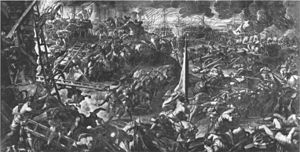Siege of Zara
| Siege of Zara | |||||||
|---|---|---|---|---|---|---|---|
| Part of the Fourth Crusade | |||||||
 Siege of Zara (Croat.: Zadar) |
|||||||
|
|||||||
| Belligerents | |||||||
|
|
|
||||||
| Commanders and leaders | |||||||
|
|
|||||||
| Strength | |||||||
|
Crusaders: 10,000 men
|
Unknown | ||||||
| Casualties and losses | |||||||
| Unknown |
Unknown Most of the population fled to Nin and Biograd |
||||||
Crusaders: 10,000 men
Venetians: 10,000 men
The Siege of Zara or Siege of Zadar (Croatian: Opsada Zadra, Hungarian: Zára ostroma; 10–24 November 1202) was the first major action of the Fourth Crusade and the first attack against a Catholic city by Catholic crusaders. The crusaders had an agreement with Venice for transport across the sea, but the price far exceeded what they were able to pay. Venice set the condition that the crusaders help them capture Zadar (or Zara), a constant battleground between Venice on one side and Croatia and Hungary on the other, whose king, Emeric, pledged himself to join the Crusade. Although a part of the crusaders refused to take part in the siege, the attack on Zadar began in November 1202 despite letters from Pope Innocent III forbidding such an action and threatening excommunication. Zadar fell on 24 November and the Venetians and the crusaders sacked the city. After spending the winter in Zadar the Fourth Crusade continued its campaign, which led to the Siege of Constantinople.
Shortly after his election as pope in 1198, Pope Innocent III (1161–1216) published several papal encyclicals calling for the invasion and recapture of the Holy Land from the Muslims. His plan to accomplish this differed from the earlier ultimately unsuccessful Second and Third crusades in several ways. Instead of the secular nobles who led the earlier crusades, this one would be, in theory, completely under papal control. Innocent's plan also called for the invading armies to travel to Egypt by sea and seize the Nile Delta, which would then be used as a base from which to invade Palestine. His call was at first poorly received among the ruling families of Europe, but by 1200, an army of approximately 35,000 was formed.
...
Wikipedia
